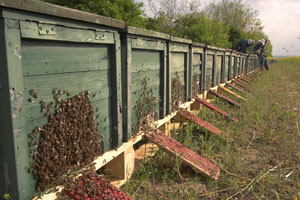I put these pictures to remind that "longhive" is not an invention. They has been used very long time. It is same with the toy called "top bar hive"
These hives are very common among commercial beekeepers here around.
Sure, it isn't a new invention. It was used before, but was standardised in 1902 by Mr. Boczonádi Szabó Imre.
These hives named after him as "Nagy Boczonádi", or shortly: "NB" hives. Its frame is huge. The dimensions of it: 42 cm (16.5") wide and 36 cm (14.2") high. This hive is also called "coffin hive". It has no supers, just one stage of frames. Usually this hive contains 14-24 frames. If it has 24 frames, it works with two queens. The nest is separated from the honey by a vertical queen excluder, to one side or even the middle of the frames.
The coffin hive is / was commonly used in Russia, Slovakia, Moldavia, Georgia, Poland, Bulgaria, Romania, but also in Austria and other European countries as well.
See also taylorsgardenbuildings.co.uk as an example from UK.
There are many odd systems in this horizontal hive compared to vertical hive. One is really, how the honey frame will be capped. In vertical hive and with low frames capped honey- nectar-new space is easy to arrange. In horizontal hive the bees' habit to arrange storage fron upp to down does not follow bees instinct to work.
When you want one capped honey box, you need 2-3 other boxes where honey rippens. In long hives these vertical layers all are inside that huge frame.
In ancient times the hive was a tube where some combs were cutted behind brood frames.[/quote]
It is true. It is against bees instict. On the other hand wild bee colonies can build nest and honey storage beside each other, if the available room makes only this possible.
At least it is difficult to stiele these hives, but some stiele only frames.
It is also true. Every hive can be locked, and also they are very heavy to steal them.
Those hives seem very old. Perhaps hives in 3 generation. it is 20 years when sosialism collapsed. that is not a reason.
No. Hives from three generations would look much worse than these. You can buy new-made long hives. See
- kaptaruzem.hu/fekrendkapt.htm
- kaptarak.hu/?cat=13
Don't have doubts, it works very well. It has benefits e.g. during migration: you only need to close the entrance, and can go.






